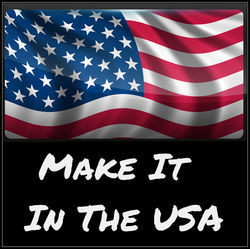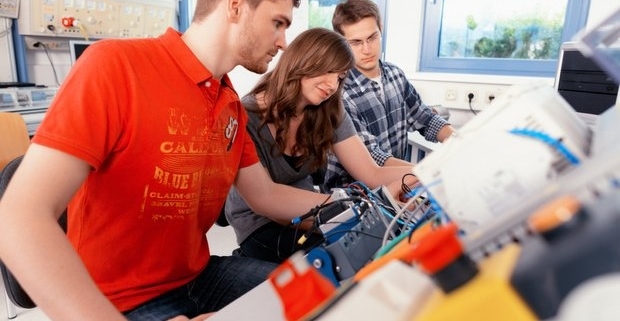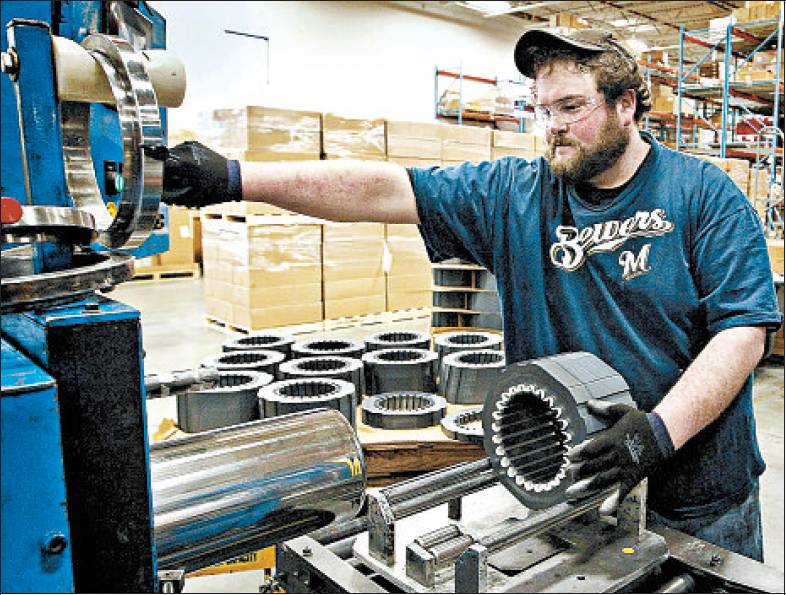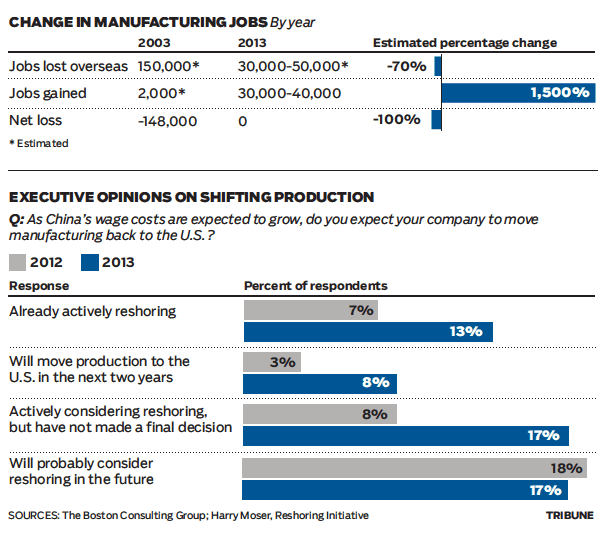The U.S. News/Raytheon STEM Index shows that STEM employment in the United States has gone up by more than 30 percent, from 12.8 million STEM jobs (as defined by the U.S. government) in 2000 to 16.8 million in 2013, and a February report by Burning Glass Technologies indicated the STEM job market is actually far larger than that. Kelly also points out that the analytical reasoning and problem-solving skills associated with science, technology, engineering and mathematics are increasingly important for jobs that aren’t traditionally defined as being in STEM fields.
“People are measuring the number of Ph. D. engineers and scientists out there, but the mechanics putting the wings on the airplanes need STEM skill sets, too,” he says. “This is not simply an issue about guys with lab coats and pocket protectors. This is way beyond that.”
Launched with support from the Raytheon Company, the new U.S. News/Raytheon STEM Index measures annual changes in key indicators of STEM activity in the United States relative to the year 2000; it is not a comprehensive measure of all STEM economic or STEM education activity in the United States and does not determine whether explicit STEM goals are being met. The Index is made up of 93 sub-indices and thousands of data points divided into eight components: ACT math and science scores, Advance Placement (AP) test scores in STEM subjects, college and graduate degrees granted, U.S. employment in STEM fields, Program for International Student Assessments (PISA) math and science scores, SAT math scores, National Assessment of Educational Progress (NAEP) math scores and interest in STEM at the high school level. It relies on data from the U.S. Bureau of Labor Statistics, the National Center for Education Statistics, the College Board, the National Research Center for Colleges & University Admissions, the ACT and the Organization for Economic Co-operation and Development.
As with other widely followed indices like the S&P 500 or the Consumer Price Index, the weights and components for future U.S News/Raytheon STEM Indices will likely change as more numerous and refined indicators become available. “For instance, we know that the way the federal government classifies STEM jobs undercounts them, possibly by a lot,” Kelly explains.
“Science, technology, engineering and math form the foundation of the global economy,” says Raytheon Chairman William Swanson. “Yet, as the STEM Index suggests, if educational trends continue, fewer qualified candidates will be available to support growth in these areas. It’s critical to our business and the United States’ long term economic outlook that we inspire young people to engage in STEM and dedicate resources to supporting them throughout their academic lives.”
Even with the most weight given to the broadest indicators — STEM employment and STEM degrees granted — the Index shows there has been only modest gains in overall STEM activity since 2000.
The component index for AP tests offers one such example. “In 2000, around 423,000 STEM AP tests were taken,” Morse explains. “In 2013, that number ballooned to 1.2 million. This shows us that despite our graph looking like AP STEM is in a major downslide, in reality there has been real growth in numbers. This is an indication of the rapidly growing popularity of all AP tests in general and that the growth in STEM AP tests is not keeping pace.”
Still, the relatively flat overall Index calls into question the effectiveness of multiple plans to increase STEM awareness and activity in the U.S., including President Barack Obama’s 2009 Educate to Innovate initiative. While the actual number of STEM degrees granted, employment in STEM fields, and the number of STEM-related AP tests have gone up since 2009, other indicators — like SAT and NAEP scores — have stagnated, and other key areas have declined.
“There’s not much evidence so far that government actions have had a significant effect,” Kelly says, stressing that some initiatives, like the Common Core State Standards, which were created in part to address the national STEM education crisis, have not been yet fully implemented.
According to the U.S. News/Raytheon STEM Index, high school student interest in STEM fields reached a low point in 2004, dropping nearly 19 percent from the base-year calculations. Interest levels climbed steadily until 2009, when they began to decline again. In spite of the intense drive to encourage students to study science, interest levels fell between 2009 and 2013 and are now just slightly below where they were in 2000.
The lack of progress among female and minority students is especially troubling in the long term.
“A big part of the problem is the continuing split that puts Asian-Americans and white males on the side of those who are driven to acquire STEM skills, and women, blacks and Latinos on the other side of the dividing line” says Kelly. “T
he labor pool going forward will not be made up mainly of white males and Asian-Americans. The labor pool will be increasingly Latino, and that group is not advancing in STEM fields right now.”
As high school students’ interest in STEM has waned, their scores on international assessments like PISA have dropped, the U.S. News/Raytheon STEM Index shows. According to the latest PISA data, released in December, students in other countries continue to outperform those from the United States in math and science.
“The big picture of U.S. performance on the 2012 PISA is straightforward and stark. It is the picture of educational stagnation,” Secretary of Education Arne Duncan said at the time. “In a knowledge-based, global economy, where education is more important than ever before, both to individual success and collective prosperity, our students are basically losing ground.”
But Kelly cautions that the issue is more complicated than just “us vs. them.” While international assessments like PISA show the U.S. is falling behind, other data used in the U.S. News/Raytheon STEM Index, like NAEP scores, show an improvement over time.
“Even with gains domestically, we can still be losing ground against our international competitors,” Kelly explains.
“There are many very good initiatives and lots of work being done to address the problem,” he continues. “But as the data show, it’s still not enough. There is a mismatch of skills and jobs, of supply and demand, and the challenge is to get them aligned again.”
In an update of its investigation last week, the FDA said it found that antiviral drug amantadine in some samples of imported chicken jerky treats sold a year or more ago, but doesn’t think it caused the illnesses. The FDA said it will continue to investigate.
Rival Petco announced on Tuesday that it would remove all Chinese-made treats from its 1,300 stores by the end of this year after shoppers pushed them to do so. The San Diego company said it has been cutting the number of those treats it sells over the past three years.
PetSmart Inc., which is based in Phoenix, owns more than 1,300 stores in North America.
“Always be aware of what you’re buying and where it’s coming from,” Levine said.
Yet that may not always be enough to keep pets safe; products stamped “Made in the USA” could still contain ingredients sourced from China or other countries, the FDA warned.
The FDA has partnered with the Centers for Disease Control and Prevention (CDC) to figure out what foods may be contributing to pet disease. The study will compare the foods eaten by sick dogs to those eaten by dogs who haven’t gotten sick, in order to determine if the jerky is really the culprit.
So far, testing of jerky pet treats from China revealed low levels of antibiotics as well as the antiviral drug amantadine in some chicken samples. Although FDA-approved for pain-control applications in humans and in dogs, the agency prohibited its use in poultry in 2006 to help preserve its effectiveness.
The FDA does not believe amantadine contributed to the illnesses, as the side effects of the drug do not correlate with the symptoms seen in the pets; however, amantadine should not be present at all in jerky treats.
Chinese authorities have agreed to conduct additional screenings and follow up with jerky treat manufacturers, and the FDA has notified U.S. treat makers of the presence of amantadine in some jerky products. The agency will also continue testing these products for drugs and other antivirals.
The FDA cautioned pet owners that jerky pet treats are not required for a balanced diet. If your pet experiences any sign of illness, including vomiting, diarrhea and lethargy, contact your veterinarian right away.

While labor and energy costs aren’t the only factors that influence corporate decisions on where to locate manufacturing, these striking changes represent a significant shift in the economics of global manufacturing.
China displaced the United States as the largest manufacturing country in 2010, as the United States’ share of global manufacturing activity declined from 30% in 2002 to 17.4% in 2012.

“And because China wants to keep that oil rig in place into August, these protests could just be the first pages.”
Tran Van Nam, vice chairman of the Binh Duong People’s Committee, said workers initially held peaceful protests on Tuesday. But disorder broke out when the numbers swelled to about 20,000.
Gates were smashed and rioters set 15 factories on fire, he said.
“This caused billions of dong (hundreds of thousands of dollars) in damages and thousands of workers will have lost their jobs,” Nam said by telephone.
“We urge everyone to stay calm, exercise restraint and have faith in the leadership of the Party and State.”
F.Y. Hong, president of Taiwan’s Formosa Industries Corp, one of the companies that was attacked, said about 300 rioters looted televisions, computers and personal belongings of workers.
“Due to the limited number of police, they couldn’t stop the looters. The situation was like in a country where there were no authorities to protect its people,” Hong said.
A police official in Binh Duong province, speaking by telephone, said about 200 people had been arrested.
“We are working on other areas in the province … We haven’t seen any injuries.”
A Singapore foreign ministry spokesman said the premises of a number of foreign companies were broken into and set on fire in two Vietnam-Singapore joint venture industrial parks in Binh Duong. He said the Singapore government had asked Vietnam to restore law and order immediately, but gave no other details.
“Everyone is terrified,” said Serena Liu, chairwoman of the Taiwan Chamber of Commerce in Vietnam. “Some people tried to drive out of Binh Duong, but looters had put up road blocks.”
RISK OF MILITARY CLASH
Story said the Vietnamese government would now be under increasing pressure to respond, which could risk a military clash at sea with China that Vietnam could not win.
Dozens of ships from both countries are around the oil rig, and the two sides have accused each other of intentional collisions, increasing the risk of open confrontation.
In Beijing, Foreign Ministry spokeswoman Hua Chunying told reporters that China was seriously concerned about the violence and had summoned Vietnam’s ambassador to protest.
China has “demanded the Vietnamese side make efforts to adopt effective measures to resolutely support eliminating illegal criminal acts and protect the safety of Chinese citizens and institutions”, Hua told reporters.
Hong Kong-listed sports shoe maker Yue Yuen, which supplies footwear to Adidas, Nike and other international brands, said it had suspended production in Vietnam because of the protests, but there was no damage to its facilities and its workers were safe.
A spokesman for global exporter Li & Fung, which supplies retailers like Kohl’s Corp and Wal-Mart Stores Inc with clothing, toys and other products, said some of its suppliers in Vietnam had halted production on Wednesday as a precautionary measure. He gave no further details.
Anti-China sentiment was also evident in Manila, as the Philippine government accused Beijing of reclaiming land on a reef in disputed islands in another part of sea, apparently to build an airstrip.
“If these reports are true, this would represent a significant step by the Chinese, potentially allowing them to extend their airborne reach,” said Story, the analyst.
The spike in tensions over the oil- and gas-rich South China Sea comes two weeks after U.S. President Barack Obama visited the region and expressed support for long-time allies Japan and the Philippines, both of which are locked in territorial disputes with China. Vietnam is also stepping up ties with the United States.
CLAIMS AND COUNTER-CLAIMS
China claims almost the entire South China Sea, an area rich in energy deposits and an important passageway traversed each year by $5 trillion worth of ship-borne goods.
Brunei, Malaysia, the Philippines, Taiwan and Vietnam also have claims on the area.
Philippine foreign affairs department spokesman Charles Jose said China had been moving earth and materials to Johnson South Reef, known by the Chinese as Chigua and which the Philippines calls Mabini Reef, in recent weeks.
He said China was reclaiming land in violation of the Declaration on the Conduct of Parties in the South China Sea, an informal code of conduct for the region.
“I think they’re to construct an airstrip there,” Jose said.
However, Richard Bitzinger, a military analyst at the S. Rajaratnam School of International Studies in Singapore, said the airstrip was unlikely to be a strategic game-changer in the South China Sea because of the difficulty in building a workable runway on the atoll.
“It would be a nice tool to have in the box of options to project power, but it is probably going to be far too small to have a huge impact,” Bitzinger said.
“At this point I would be very surprised to see this develop into any airbase of any significant size … China’s holdings in the Spratlys are just too small.
“It is probably as much a political move as anything else, the laying down of one more marker to solidify their position and continue their campaign of creeping assertiveness.” (Additional reporting by Donny Kwok and Greg Torode in Hong Kong, Faith Hung in Taipei, Nguyen Phuong Linh and Rachel Armstrong in Singapore and Megha Rajagopalan and Michael Martina in Beijing; Writing by Raju Gopalakrishnan; Editing by Mike Collett-White)
|
|
Domestic production gave them the ability to produce quickly and fill reorders. There is an existing production base in the region and the move could help retain U.S. jobs, which was important for the Ukrainian-born Sobolevs, who both emigrated as children from the former Soviet Union, meeting many years later in Los Angeles.“I’m from Odessa and Michael is from Donetsk,” said Galina Sobolev, the designer behind Single. “We’ve lived in this country for 37 years. We both felt very strongly about giving back to the community and giving back to this country.” The company had always kept a portion of its production local to allow for quick turn and reorder business. “The majors really loved that we could do that,” Galina Sobolev said. “[But] at one point when the production of all our silks got really huge, we were doing maybe 60 percent domestically and our China production went up to 40 percent.” The husband-and-wife team began investigating what it would take to move all production back to America. “We started pricing some of the product,” Galina Sobolev said. “The difference was so insignificant that we decided to absorb it into the cost. [We said,] ‘For the amount of profit that we’re going to lose by producing in the U.S., we’d rather forgo the extra money and create jobs here for local factories.’” |
These days, 100 percent of the Single collection is produced in the United States with the exception of a few labor-intensive items in the Holiday collections, such as beaded dresses made in India. And the move has paid off—particularly among Single’s international retailers.“We have a lot of Canadian customers who are very interested in the fact that the product is made in the USA,” Sobolev said. “And we have a lot of European customers. In Belgium and Germany, they are very adamant. If the whole collection is made in USA, they triple their orders.”
Domestic manufacturing has allowed the company to fill reorders when a style suddenly takes off for a retailer. “Our edge is the fact that we can turn goods in two to three weeks, which nobody in China can do,” Sobolev said. “For clients such as some of the onliners, they can chase business.”
That was the case recently for one retailer that purchased a few stock inventory pieces from a previous collection to sell online. The retailer bought 18 units of one dress style—“That’s all we had in stock,” Sobolev said—and oversold it by 390 units. Fortunately, Sobolev was able to secure the fabric from the original local vendor and quickly put the reorder into production.
“From the day of the order to the day it [left] our door it was 11 days. And we just got another reorder from them for, I think, 460 pieces of the same dress,” she said.
Neiman Marcus’ Cusp department had a similar situation with Single’s “Janessa” jumpsuit, Sobolev said.
“They had an 83 percent sell-through, and they even sold out of it online,” she said. “We were able to do a quick reorder for them for 60 or 80 units. Just the fact that we can do this so quickly and they’re able to reorder, it’s very exciting for them. This is the kind of edge domestic manufacturing allows us.”
Spread The Word
Every piece in the Single collection has a label that reads “Single Los Angeles.” Each item has a hangtag that reads “Made in USA,” although Sobolev said she’s planning to change that to read “Proudly Made in USA.” The linesheets, lookbook and website will also soon have “Made in USA” prominently displayed. At the Single showroom in Atlanta, the sales staff display signs that read “This Collection Is Made in USA.”
“The buyers get very excited when they find out that the collection is Made in USA—especially in our Midwest territories and in the South and Southeast,” Sobolev said. “At the regional markets, it’s the first thing my sales team tells every buyer that walks in.”
Sobolev frequently attends the regional markets in Dallas and Atlanta, as well as the New York Market five times per year.
“In New York, nobody cares where things are made, honestly. It’s all about the price,” she said. “I’m getting the most support for made in USA from Texas, from Louisiana, from specialty stores in the Carolinas.”
Much of the Single collection is made using European fabrics, but Sobolev looks for domestic resources, as well. “We have one lace that we have been running for about 10 years now. It’s a very vital part of our Holiday collections,” she said. “It’s made in this little factory in New Jersey. The machine itself is about 200 years old [and] imported from England. And it’s a beautiful re-embroidered lace. It looks like [a high-end Italian] lace, but it’s a lace that can be worked into our contemporary price points.”
Sobolev said some retailers ask if the company will source a style overseas to reduce the price.
“Of course, everyone is price-sensitive these days,” she said. “But sometimes we have to put our foot down and say, ‘Sorry, we can’t make it at that price. However, we can do it at this price, and you can have a product in your store that says ‘Made in USA.’”
California Sportswear
Founded in 1994, Single sells in higher-end department stores such as Saks Fifth Avenue and Neiman Marcus, as well as higher-end specialty stores and boutiques around the world such as Tootsies in Texas, Montmartre in New York and Mendocino and Want in Canada. Although the company started as a sportswear maker, over the years it became well known as a dress resource. For Fall, Sobolev is returning to the brand’s sportswear roots with a collection of luxe separates Sobolev calls “California dress-up casual.”
“If you look at the way people are dressing today, it’s a lot easier for a girl when she’s going on a date to run in and buy two new blouses to wear with her favorite leather legging or skinny jean,” she said. “Unless she needs a dress for a specific occasion, I’m seeing more of a turn to an easy, casual kind of dressed-up sportswear. It doesn’t mean we’re not doing dresses anymore. There’s still two or three dresses in every group, and we still have
our assortment for our customers that are very much into dressing that career gal.”
Private-label businessIn addition to Single, the company has a strong private-label business manufacturing for a handful of brands and retailers.
The company also produces exclusive Single collections for retailers such as the White Single Dress label, which sells at Rue La La.
“We do thousands of structured dresses for Boston Proper, and we have for the last 15 years,” Sobolev said. “That’s the beauty of being able to turn a 600-unit reorder in three to five weeks domestically.”
The Sobolevs’ private-label business has grown organically as word gets out that the company is a resource for brands looking for domestic production. “We have become kind of like the Intelof the fashion community,” Sobolev said. “[People will say,] ‘You want to make something domestically? Call the people at Single. They can turn things in two to three weeks.’”
New Brand Extensions
The company recently added plus sizes for Saks and has since expanded the offering to other retailers, such as e-tailer Madison Plus. Although still in the early stages, the plus-size capsule collection fills a void in the contemporary market for plus sizes.
“There aren’t a lot of choices for the [contemporary plus-size] consumer,” Sobolev said. “We really invested in developing the blocks, and we got a great fit model.”
Sobolev hopes to expand Single’s plus-size offerings into a stand-alone collection.
“I would love to turn this into more of a proper business—have it not just be a small capsule segment but really expand it on various levels,” she said.
Another new concept in the works is the Single men’s underwear line developed by the Sobolevs’ 24-year-old son, Julian. Still in the test stages, the collection features the Single name and an American flag on the elastic waistband.
Just as Single is committed to domestic production, Galina Sobolev said she wishes more manufacturers and retailers would commit to Made in America product. Retailers, in particular, could highlight American-made products in their stores, she said.
“Why not have a section for Made in USA?” she said. “The manufacturers today have a responsibility—we all, as Americans, have a responsibility—to this country and the security of its economy and the future for our children.”
The move is part of a sea change in American manufacturing: After three decades of an exodus of production to China and other low-wage countries, companies have curtailed moves abroad.
Some, like Generac, have begun to return manufacturing to U.S. shores.
Although no one keeps precise statistics, the retreat from offshoring is clear from various sources, including federal data on assistance to workers hurt by overseas moves.
U.S. factory payrolls have grown for four straight years, with gains totaling about 650,000 jobs. That’s a small fraction of the 6 million lost in the previous decade, but it still marks the biggest and longest stretch of manufacturing increases in a quarter of a century.
Harry Moser, an MIT trained engineer who tracks the inflow of jobs, estimates that last year marked the first time since the offshoring trend began that factory jobs returning to the U.S. matched the number lost, about 40,000 each.
“Offshoring and ‘reshoring’ were roughly in balance — I call that victory,” said Moser, who traces his interest in manufacturing to his parents’ work at the long-closed Singer Sewing Machine plant in New Jersey. (He once worked there too.) He now runs the Reshoring Initiative, a Chicago nonprofit that works with companies to bring manufacturing jobs back to the U.S.
Several factors lie behind the change.
Over the past decade, Chinese labor and transportation costs have jumped while U.S. wages have stagnated. Manufacturing also has become more automated, further reducing labor’s weight in the cost equation.
The boom in natural gas production in the U.S. has led to a 25 percent decrease in gas prices in the U.S., contrasted with a 138 percent increase in China, according to The Boston Consulting Group.
Many U.S. manufacturers also report growing problems with quality control of goods made in China. “We got to the point where everything we were bringing in had to be inspected,” said Lonnie Kane, president of apparel-maker Karen Kane, noting that his company used to check just 10 percent of goods from China.
“Now prices are escalating, quality is dropping and deliveries are being delayed,” he says. In the past three years, Kane has shifted 80 percent of his production from China back home.
Expansion in the domestic apparel industry remains unusual because the labor-intensive work can be done in many low-wage countries.
But in other industries, a growing number of domestic and foreign companies — including General Electric, Caterpillar, Toyota and Siemens — are opting to build or expand their facilities in the U.S., particularly in the Southeast, where labor costs are low.
For the first time, some small contract manufacturers in the U.S. are beating bigger rivals in Asia, the center of global industrial production.
At Zentech Manufacturing in Baltimore, the company’s president, Matt Turpin, recalls his skepticism when salesmen told him two years ago about their efforts to land a contract making 5,000 to 10,000 wireless printers. He was sure an overseas competitor would get the work.
“I don’t know why you’re wasting your time chasing that business,” he says he told the sales force.
Zentech ultimately won the contract, and Turpin says the company added at least five full-time employees to his shop, where the front office window is draped with a large American flag.
William Davidson, a test technician at Zentech, now earns $17.50 an hour working on those printers and other company products. Before getting hired at Zen-tech three years ago, Davidson, 62, had been unemployed for 18 months. His previous employer, a Delaware repairer of cable boxes, had moved its operations to Mexico.
“The worst part of it was we had to help them pack things up for the move,” he says.
The offshoring “didn’t feel right” because of the families affected by layoffs, he said, but the company needed to make the move to remain competitive.
Generac grew rapidly over most of the rest of the decade. Its sales rose to $1.5 billion last year, and it now has about 3,300 workers, including 720 in Whitewater, its largest plant. But the past decade also saw costs surge in China while they rose little in the U.S.
What began as a $100 gap in the cost of producing an alternator narrowed as the Chinese yuan jumped in value and Chinese wages and other costs soared.
The tipping point came when Generac had enough sales to justify investing millions of dollars in new equipment for the Whitewater plant. The company can now produce an alternator with one worker in the time it took four workers in China.
Brad DeNoyer, manufacturing and distribution leader for accounting and advisory firm Baker Tilly Virchow Krause LLP, said a lot of middle market manufacturers supplying larger companies are starting to come back to the U.S.
“There’s just not necessarily a drive to go there anymore and there is talk about coming back,” DeNoyer said. “Five to 10 years ago, the work was leaving and going overseas, even the smallest of companies was going to China. Now the faucet has stopped and there is talk about whether to come back.”
But some manufacturers are just starting to have conversations with Milwaukee-based suppliers about re-shoring.
Frank Krejci, president and chief executive officer of Strattec Security Corp., also heads up a contract die-casting division called Strattec Component Solutions. Companies that used to get castings from China are now looking to bring back the work to the U.S., but this push to come back home isn’t going to happen overnight, Krejci said.
“This is not an impulse buy at a grocery store,” Krejci said. “The choice is…do you move inventory or tools? What manufacturers are more likely to do is create a separate set of tools, then ramp up in America and shut down in China. But they are still getting the parts from China.
“But next year they are coming out with a new and improved version of their product. And instead of having the new tools coming from China, now they are making it in America.”
Krejci also said more companies are auditing his firm to determine if they might need his company’s services six months or two years down the line for their next product generation.
What does that mean on the jobs front?
Jeff Sachse, regional economist for the Wisconsin Department of Workforce Development, said that he’s seeing manufacturing companies in the four-county metro region have been hiring at a stable rate. The re-shoring effort has been segmented, but companies have also been reinvesting in some production facilities and cutting costs.
“There is a lot of interest in re-shoring from China…Some of that was driven by labor costs because they dropped during the recession and a lot of companies got rid of the high-wage earners because a lot of that was driven by seniority, but there was definite cost cutting going on,” Sachse said. “So we’re seeing relatively lower wage rates in assembly here than there used to be and we are seeing more competitive costs compared to other countries like China.”

He said that maintaining a healthy domestic steel industry was also vital to the national security.
“We should be careful that a cost-analysis is done to make sure it takes into account jobs,” said Sweeney (D-Goucester), a vice president and general organizer with the International Association of Ironworkers union, whose members erect steel structures. “There are certain things this country has to have to protect ourselves and to be able to produce steel is very important.”
As with all bills that would impose restrictions on the Port Authority, identical legislation to Sweeney’s measure (S-2061) must also be adopted in New York State. He said he was still seeking a New York counterpart.
If Sweeney’s measure becomes law, it would apply to many of the projects slated under a $27.6 billion 10-year capital plan approved by the Port Authority in February.
The use of foreign steel in public projects became an issue in the region last year, when the Metropolitan Transportation Authority and the Port Authority allowed Chinese steel to be used for work on the Verrazano-Narrows and Bayonne Bridges.
Critics of Chinese-made steel, including the United Steelworkers union, complained that U.S. producers could not compete with mills in China, which pay workers as little as $15 a day and benefit from legal and financial support from the Chinese government. China is by far the world’s leading steel maker.
Sweeney said his legislation was prompted by a Star-Ledger article on the controversy in September.
The contractor for the Bayonne project, a partnership of Oklahoma-based Kiewit and the Swedish construction giant Skanska, eventually decided to use Italian steel instead of Chinese, along with some American steel.
The U.S. government already requires domestic steel to be used on public projects
that receive federal funds, and Sweeney said his bill would unburden those who pay bridge tolls by ensuring that Port Authority projects were eligible for those funds.
As in the rest of the country, steel manufacturing has been in decline in New Jersey for decades, and only a handful of operations remain, including MRP LLC in South Plainfield, which has supplied steel beams for the World Trade Center site, and a plant in Sayreville run by Gerdau Ameristeel.
The Port Authority declined to comment specifically on Sweeney’s bill. However, agency officials noted that the $1.5 billion Goethals Bridge replacement project is subject to a federal requirement that 99.9 percent of materials be produced domestically, while the agency’s own request for proposals on a $3.6 billion replacement of the Central Terminal Building at LaGuardia Airport calls for at least 51 percent domestic materials.
Daniel J. Ikenson, a trade policy specialist at the Cato Institute, said Sweeney’s measure was a misguided appeal to patriotism that would inflate the cost of public projects.
“It’s just common sense,” Ikenson said. ” Only a rudimentary understanding of supply and demand is needed to see that limiting competition for state procurement ensures that taxpayers get a smaller bang for their tax bucks.”
Last fall the agency said that it allowed the use of Chinese steel to expedite the Bayonne project, which is intended to allow larger container ships to reach terminals in Newark and Elizabeth once an expansion of the Panama Canal is completed next year.
But Sweeney rejected the notion that domestic steelmakers lacked the capacity or speed needed in such situations.
“This isn’t that hard to figure out,” Sweeney said. “If you know you’re going to build a bridge, you contact steel manufacturers in the United States and you say, I’m going to need this may tons of steel.’ They can do it.”
INQUIRIES
Media: PR Department
Partnership: Marketing
Information: Customer Service











